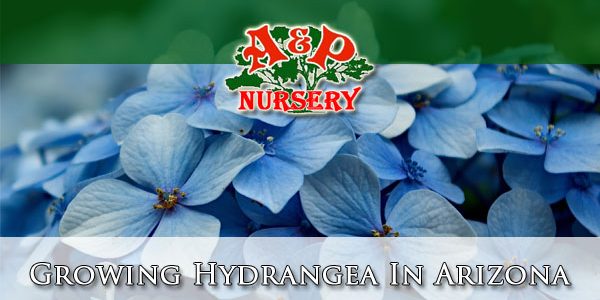Are you searching for “Growing Hydrangea In Arizona” because you want to add one of the most beautiful shrubs to your landscape? If so, A&P Nursery can help. Hydrangea, for the uninitiated gardener, is a genus of about 70 species of flowering plants. They are native to the Americas and the south and east of Asia. Generally the shrubs grow to about 3 feet to 9 feet tall, yet some species can grow as high as near 100 feet. While the greatest diversity of Hydrangea exists in Asia, we can still find, plant, and grow beautiful examples right here in Arizona, as long as we choose the right Hydrangea species.
Selecting The Right Hydrangea
Arizona covers USDA zones 5 through 10 and can get quite hot in the southwest area of the state. The Hydrangea is rated by the U.S. Department of Agriculture as a 3 through 9 in hardiness depending on the species. This means for the hotter areas of Arizona, like Phoenix, certain species are better and will grant the gardener with greater success. If you want to check which hardiness zone your zip code is in, please click here.
Heat Tolerant Hydrangea Species
If you want to choose a species that will work anywhere in Arizona you might choose from the following: Bigleaf Hydrangea, Oakleaf Hydrangea, or Smooth Hydrangea. All of these species are rated for the various climates that are found in Arizona and will thrive as long as their other needs are met.
Bigleaf Hydrangea
While being native to Japan the Bigleaf Hydrangea is a deciduous shrub which grows to about 7 feet tall by about 8 feet wide. They bloom out with flowers in the summer and autumn with large blue or pink heads of flowers. In landscaping people love it for being a boarder or planting it at the back of a flower bed. With its large size, and rich foliage it makes a great backdrop for your annuals or perennials.
Oakleaf Hydrangea
A native to the Americas this Hydrangea species grows wild in the Southeastern United States in places like Louisiana, Florida, North Carolina, and Tennessee. It is also a deciduous shrub that features white showy flower heads and is widely used in gardening and landscaping. This plant is common planted near large trees such as magnolias, oaks, hickory, and others.
Smooth Hydrangea
The Smooth Hydrangea is also known as the Sevenbark, or wild hydrangea and is native to the Eastern United States. It native area of growth stretches from southern New York all the way to the panhandle of Florida and out into the flatlands of Kansas and Oklahoma. They typically grow to about 10 feet tall when mature and bloom out with flowers around May and June. Smooth Hydrangea is used extensively as an ornamental landscaping plant and was even used medicinally by Native Americans.
Choosing Where To Plant
Depending on which of the species you chose to purchase you will need more, or less shade. Both the Smooth and Oakleaf Hydrangea prefer part shade. While the Bigleaf Hydrangea grows well with direct sunlight with afternoon shade that helps reduce wilting. If you are going to plant your Hydrangea in full sun in Arizona you might consider planting the Panicle Hydrangea, which can withstand the greatest sun of any Hydrangea species. Ultimately you should talk with your plant nursery specialist about your landscape layout and where your favorite hydrangea will grow best based on how tall your house is, and the landscape layout.
Preparing Soil For Hydrangeas
Arizona’s soil isn’t much like the native areas of the Hydrangea such as the Eastern United States or Asia. Our desert environment tends to not have the organic matter needed to grow the Hydrangea successfully. The soil should be amended with a 1-2 inch layer of compost across the surface of the soil. Compost then should be worked into the top foot of soil. The addition of organic material helps provide the nutrients needed and also assists with drainage in clay or compacted soils.
How To Plant Your Hydrangea
While it is possible to plant Hydrangea year round the best time of year to plant them is when it is cooler. The fall, winter, and spring are preferable and the earlier the better to give the root system a chance to develop before the heat sets in for the summer.
Digging The Hole
Once the soil is amended, dig a hole which is the same height as the root ball and about 3 times the width. Hydrangea as a rule should be planted about 6 feet away from other plants so it will have room to mature.
Planting
Set your Hydrangea in the center of your hole and return the soil around the root ball. Once the dirt has been returned you will want to mound up a ring of soil around your root ball which is about 3 inches high. This mini moat will keep water near the root ball and help you avoid drought problems.
Mulch & Watering
A layer of mulch that is about 3 inches deep should be used around the base and the Hydrangea should be watered thoroughly. Soil should be kept moist yet not saturated consistently for the first months after you plant your Hydrangea.
Continuing Care Tips
Watering – Most of the time 1 inch of water a day is enough for the Hydrangea, yet in especially hot weather doubling that amount to 2 inches per day helps avoid wilt. The leaves of the Hydrangea are prone to leaf spot disease which is caused by watering their leaves, so try to keep all of your watering on the soil.
Fertilizing – The Hydrangea has a moderate fertilizer need and should be treated with a slow release dry fertilizer with a 10-10-10 ratio and 2 cups per every 100 square feet in the spring once the plant beings to green up and once again when they begin to flower.
Buying Your Hydrangea
If you live in the Phoenix area in cities like Gilbert, Queen Creek, or Mesa, Arizona you can visit one of our 4 convenient East Valley locations to get help choosing the species, location, and even choose to have professionals transport and plant your Hydrangea. We make gardening and landscaping easy and enjoyable for our customers with tailored advice and services for every gardening need. Stop by or call one of our locations listed below and we will be happy to help you select and plant your Hydrangea in Arizona.
A&P Nursery For All Your Gardening Needs
With 4 east valley locations our team can help you find the perfect trees and plants to take your landscape from ordinary to extraordinary. In addition to selling trees and plants we partner with companies that will plant your trees or plants and care for them as long as you wish. That means all you need to do to get your landscape looking it’s best is stop by and browse our trees, choose your favorite, and leave the rest of the work to the pros.
Call or stop by one of our 4 locations today!






